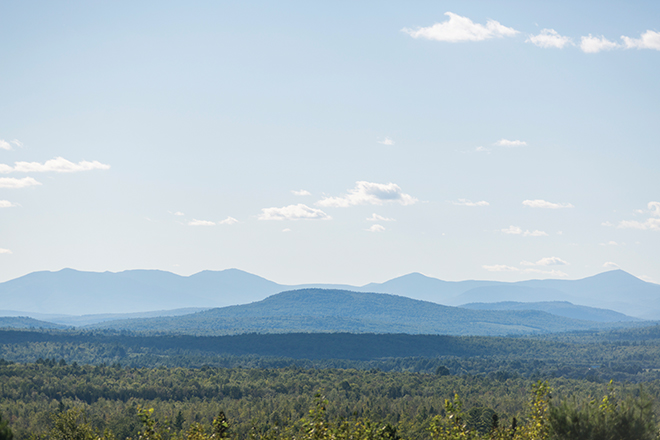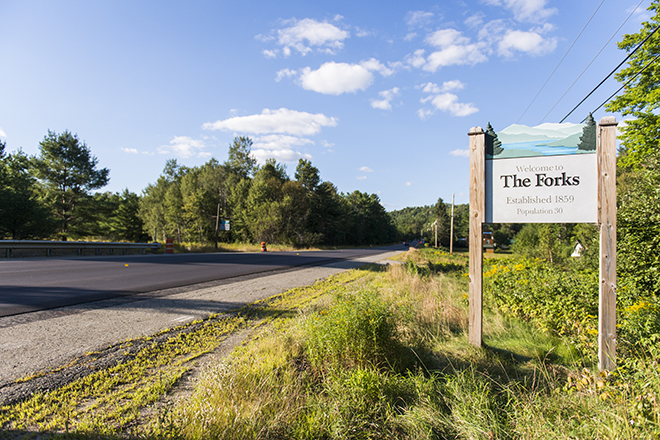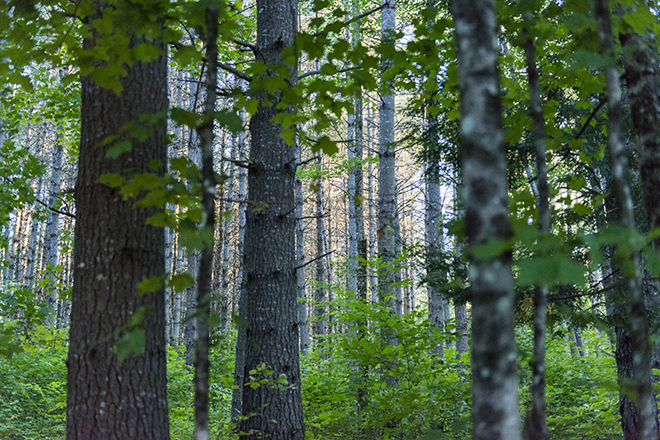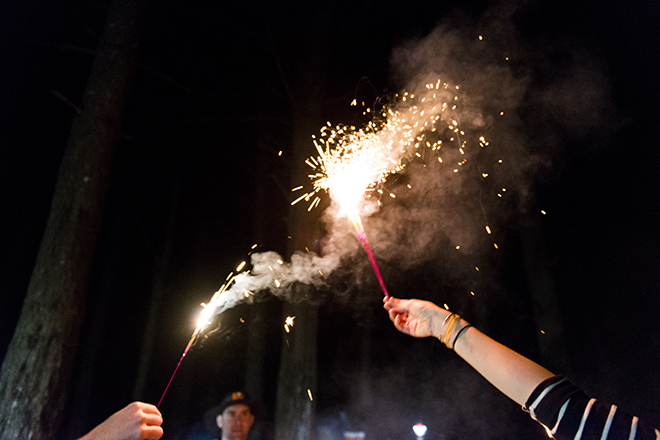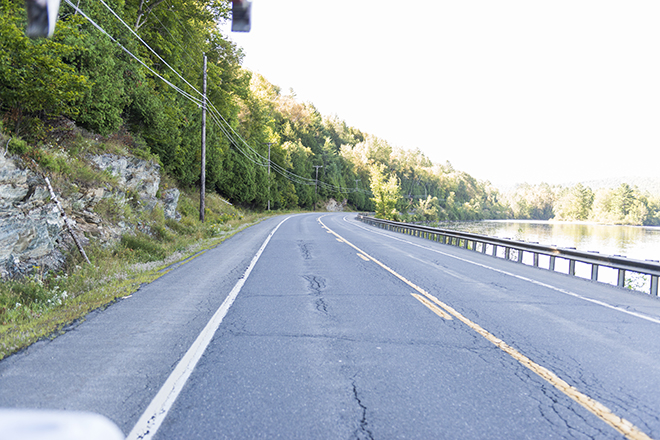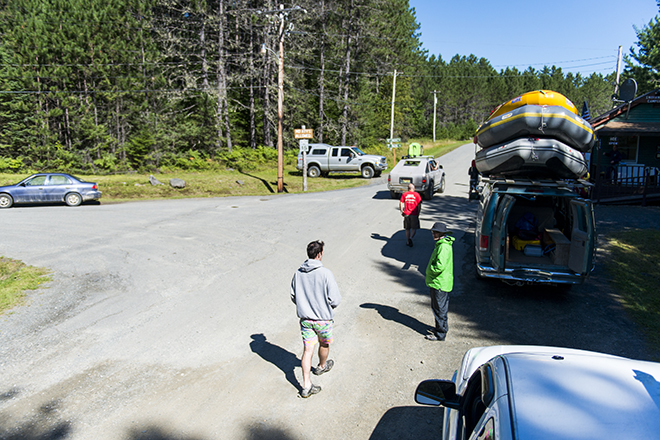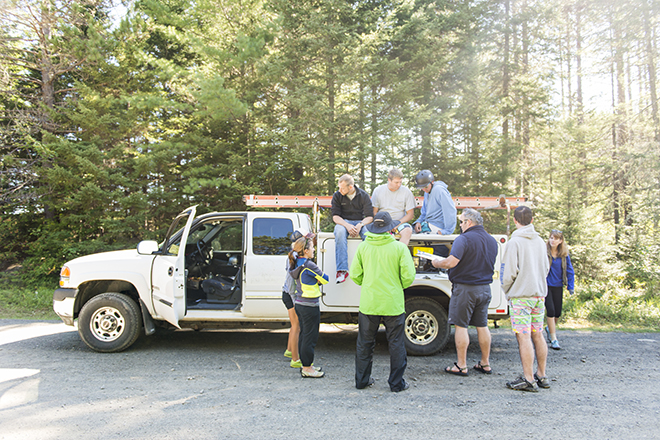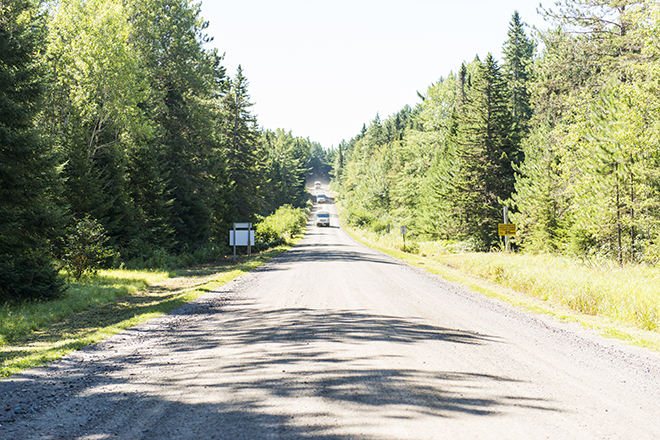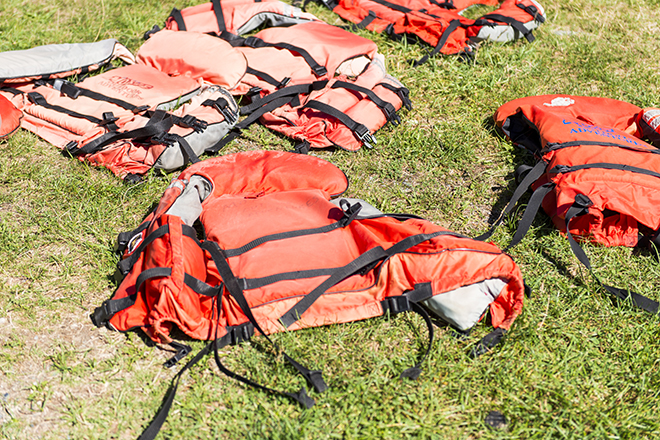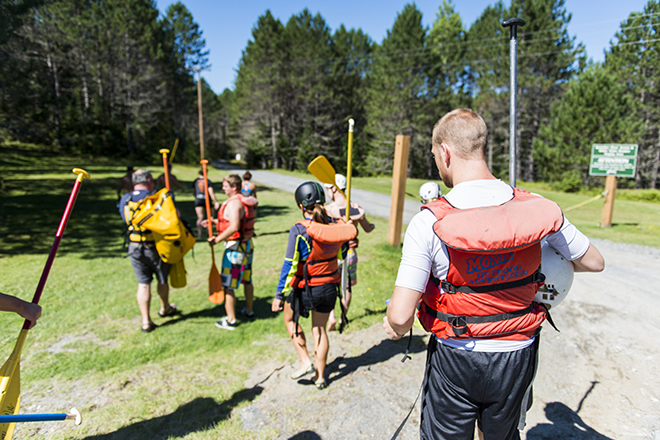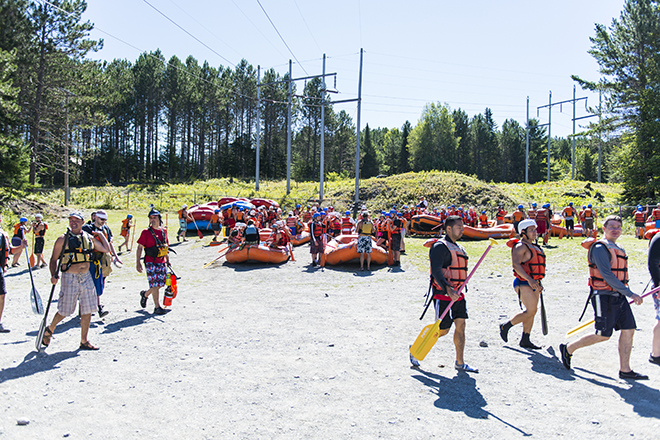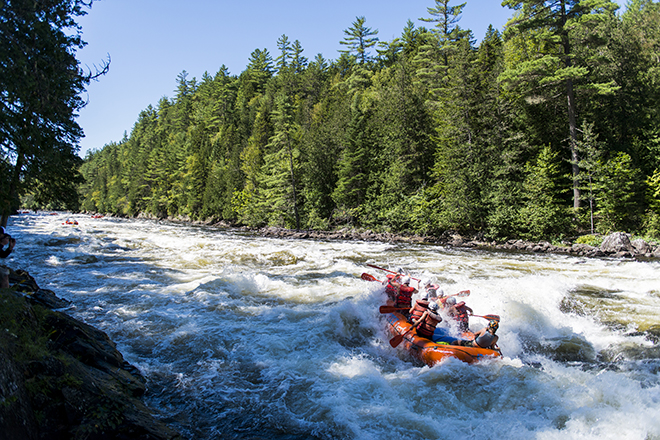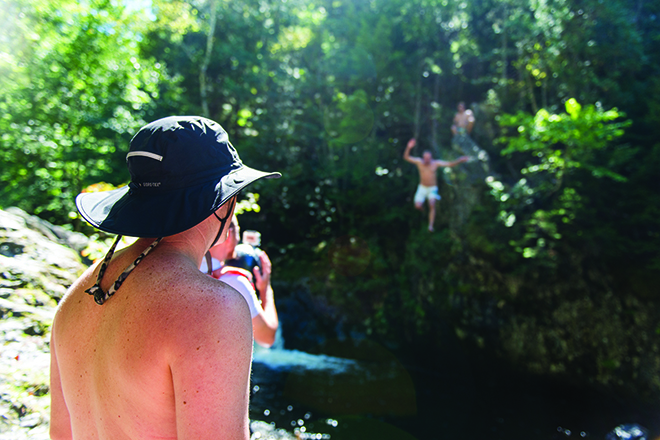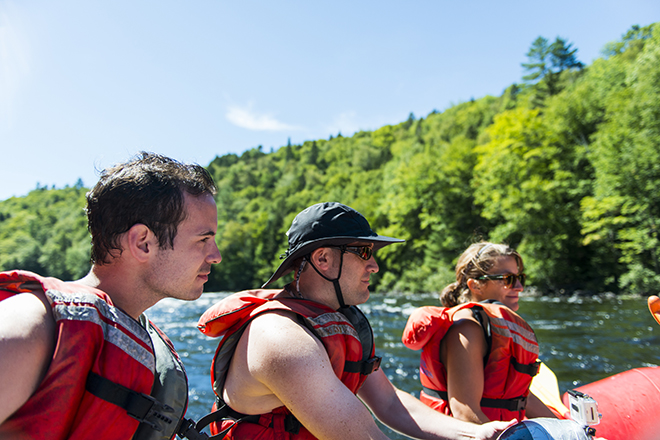Whitewater Rafting on the Kennebec + Camping in the Forks
Most people strive for smooth sailing: good times and clear skies. But there are those who prefer a rougher ride. As wave after icy wave of river water hits me hard across the face, I wonder which kind of person I am. Do I truly crave serene waters, or do I secretly need to spend my time crowded onto an inflatable raft with eight strangers and one very loud, very brash, seemingly fearless guide?
By the time I ask myself this strangely basic question about my nature—and this particular “leisure” activity—it’s much too late to turn back. I am just minutes into a seven-hour journey down the Kennebec River. My torso is encased in a thick layer of neon orange foam and my mouth is glued shut with the metallic taste of fear. Hair plastered to my face, I am only vaguely aware of the dull pain building in my recently sprained ankle. I’m disheveled and displaced, yet I don’t care about any of that—right now, I feel so infinitely alive. I would like to whisper my revelations to my neighbors on the raft, but there is no time. The crashing crest of water known as “Big Mama” is coming up, and Jimmy is bellowing, “all forward, all forward, paddle harder, ALL FORWARD!”
It’s one of those late summer weekends when greenery hangs thick and heavy in the hot air and a mere glimpse of a river feels like a promise fulfilled. We drive to our campground late Friday afternoon, arriving just in time to pitch our tent before dusk falls. At this point, Jimmy Rodney is just a casual acquaintance, and people sprawled around the campfire are all just nameless, intimidating faces. I have come here with Sean Thomas, our staff photographer and my frequent companion on food writing missions, and my boyfriend, Garrett. The rest of our party is composed of two sisters, their husbands, a wayward hipster cousin from Brooklyn, and an old friend of the crew. Our humble three-person contingent is quite literally crashing the party. But we came here to raft, and come hell or high water that is what we will do.
“Here” is a place called The Forks.
In Somerset County, there is a place too small to be classified as a town. This plantation is rumored to have a population of just 35, although the influx of summer adventurers makes it far more crowded. Named for the Y-shaped junction of two rivers, it is where the Dead River crashes into the Kennebec, terminating its 43-mile run. Swept into the Kennebec, the Dead is forced to change directions and head south. Like cars merging on a highway, this creates a sudden increase in volume, noise, and motion. Unlike cars merging, it does not slow the flow. Instead, the river rushes forward, careening over rocks and through gorges.

At 6 a.m., the river is slow, tired, and thick with mist. But wait a few hours and that will change.
But this natural marvel is not as pristine as it sounds. The river’s flow is shaped and determined by human hands—or, rather, human inventions. Upriver, there is a dam that controls the water level by releasing specific amounts of water—a volume that is determined by the amount power producers are willing to pay that day. As a result, the appearance of the river changes from hour to hour. First thing in the morning, it is placid and serene as mist rises from the water in a thick blanket that coats your eyelashes with tiny prisms. But just a few hours later, after the Brookfield Renewable Energy Group has opened its gates, the river swells with an additional 5,000 cubic feet of water per second. The raging water brings out the rafters, and the kayakers, and the lonely, brave paddleboarders. Suddenly, the sluggish river is transformed into a playground, complete with the shrieks, hollers, and cheers of an elementary school at noon.
According to Cliff Stevens, who runs the whitewater outfitter Moxie Rafting, there can be up to 1,200 people on the river at any one time. But that’s only the commercial limit. The private limit is 1,500, which counts anyone in a watercraft. Eight miles of water, rushing down from the dam at 5,000 cubic feet per second, packed with 2,700 adrenaline junkies navigating class IV rapids—if that’s not a party, I don’t know what is.
“That’s the best run we’ve ever had on Big Mama,” Jimmy says. In this context, “best” means it was the most violent, with the fewest casualties. Everyone managed to stay inside the raft, despite the river’s best attempts to dislodge us. Although he is not associated with any company, Jimmy is an expert on the Kennebec River. When he says that was the best run, I believe him. And when he says Big Mama is the one to hit hard, I shiver a little, but I believe him.
Jimmy doesn’t give a damn about smooth sailing. Loud and funny, brash and aggressive, he doesn’t glide through life gracefully. He isn’t someone who can tap-dance around topics or persuade with a subtle word. But put a paddle in his hand, and his demeanor changes. The tattooed kid from Brooklyn stops cracking jokes, and the cute married couple stops chatting about their kids. Even though they have done this river numerous times, there is still a respect for Jimmy’s authority. Because without Jimmy, we might all be trapped under the raft, scrambling against the slippery underside of the tipped boat like drowning rats.
But that’s the worst-case scenario. For the most part, whitewater rafting is a very safe activity. Children as young as eight can enjoy the river, and often do, thanks to guiding services like Moxie. “I’ve seen industry-wide that the business is shifting towards families,” Cliff says. “People are coming up for days and not spending them in the bar.” Instead, these families are coming to The Forks to partake in a little wholesome bonding time.

A raft makes a quick descent down the Kennebec.
“It’s an exciting and forgiving river. It’s so deep, and so wide. It gives you a lot of flexibility in how you run the rapids,” explains Cliff. “You can be aggressive or conservative.”
While our trip fell into the “aggressive” category, plenty of guides choose to skip the swells of Big Mama, particularly when a child is on board. There were no children present for our trip, but as Brian Giguere, one half of the aforementioned cute married couple, explains, that won’t always be the case. “In another year or so, our daughter Finley will be allowed to go on the raft below the whitewater,” he says after we’ve dried off and returned to the campground. “And the year she turns ten, she’ll be on the boat going down the whitewater. But I know Jimmy won’t let her sit anywhere but right in front of him,” he adds with a laugh.
I had also noticed Jimmy’s protective instincts on several occasions, like when he grabbed the back of my life jacket to keep me from bouncing out of the raft, or when, later, he picked me up and carried me off a ledge where my footing was unsteady. And he wasn’t the only one to lend a hand or an arm, or any useful limb. There is something about crashing down a river in a small boat that seems to create a fast sense of community, while breaking down physical boundaries.
In other words, once people have seen you scared white and red, sweating bullets and cursing loudly, they’re a lot more likely to slap you on the back, give you a hug, or push you into the water. Fear, even the thrilling, fun kind, is a powerful bonding agent.
Another great way to get to know someone fast? Spend a night in the woods with them. Staring into a fire is only entertaining for the first 30 seconds, so conversation is a necessity. It makes sense that in our age of screen time and Facebook chats and other digital and sometimes distancing mechanisms, more parents are heading out to the woods and onto the water. The twenty-somethings who once visited this small town for the rafting and bar culture are getting older, growing up, and bringing their kids along for the ride.
“We call it ‘controlled chaos,’” says Brian. “It’s fine for kids. It’s all about the adults paying attention.” Brian and his wife, Jess Cady-Giguere, have been taking these trips for years, along with Jess’s sister, Alicia Cady-Malette, and her husband, Ace Malette. They refer to the annual excursions as “cousins’ trips.” In a few years, the cousins’ trips will change dramatically. Says Brian, “The cousin trip will transfer onto the next generation.”
For now, however, we’re all child-free and wide-awake. For a town of only 35 people, this area has a bustling nightlife. Driving along Route 201, I had noticed few houses, but quite a few bars, taverns, and diners. Fortunately, we don’t have to go far to get a taste of the after-dark activities. We’re camping at Three Rivers Whitewater, which is also a venue for the Maine Outdoor Film Festival. It might seem odd to hold a film festival this far off the beaten path, but one look around at the lush green woods, the wide river, and the empty road that seems to stretch endlessly into the wilderness, and I remember: this is why we’re here. Water, woods, sky, and adrenaline—which also, in short, describe the movies on view tonight.
A big open field has been transformed into an outdoor theater; tents for various retailers line the outside of the space alongside food vendors and a popcorn machine. As the light fades from the sky, the energy rises. People from all over have come to attend the festival. I meet artists from Portland, a filmmaker from Brunswick, and a couple of extreme sportsmen from Canada. I lose my companions in the crowd, and find myself deep in conversation with a girl from California. Grungy and pretty, she tells me about her passion for rock climbing and why she moved to Maine. She asks me what I’m doing in The Forks, what brought me here. For a moment, I forget about my writing and my observations and interviews and say something that’s not strictly true, but completely honest.
“I love the river, the rush. I live for this kind of thing.”


